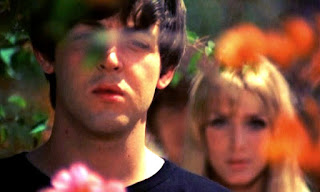On February 15th, 1965 the Beatles met at Abbey Road Studios to begin work on a batch of songs for the soundtrack of their second feature film. The afternoon session was spent on Ticket to Ride, which featured Paul playing lead guitar. In the evening, the group started rehearsing Another Girl, a song that Paul had written only days earlier while on holiday in Tunisia. Their new method of working on this day saw them perfect the basic track through much in-studio rehearsal (a luxury no other act was afforded) before attempting an actual take. Thus, take one was all that was necessary for the master.
Overdubs included a double-tracked lead vocal by Paul and backing vocals by John and George. A good deal of time was then spent on George trying to do a flourish using the tremolo arm of his guitar for the end of the song. The seventh attempt (out of ten) was deemed best. The following day, however, Paul elected to do it himself, even adding a lead guitar passage throughout the song, thus usurping George's role for the second time in two days.
The song itself is a rather lightweight piece, with lyrics that are truly callous in the manner that the singer dismisses one girl in favor of another. Though McCartney also offered Tell Me What You See for the soundtrack, Another Girl was probably chosen instead due to it being a more uptempo number.
On February 27th, less than two weeks after recording the song, the boys were in the Bahamas miming to it. It is the final new number to be introduced, appearing quite late in the film. The sequence shows the band playing on a reef and cavorting with some girls in the water, with Paul occasionally using a girl in a bikini as a stand-in for his bass guitar. This was the last time the Beatles would ever perform the song in any way.
Overdubs included a double-tracked lead vocal by Paul and backing vocals by John and George. A good deal of time was then spent on George trying to do a flourish using the tremolo arm of his guitar for the end of the song. The seventh attempt (out of ten) was deemed best. The following day, however, Paul elected to do it himself, even adding a lead guitar passage throughout the song, thus usurping George's role for the second time in two days.
The song itself is a rather lightweight piece, with lyrics that are truly callous in the manner that the singer dismisses one girl in favor of another. Though McCartney also offered Tell Me What You See for the soundtrack, Another Girl was probably chosen instead due to it being a more uptempo number.
On February 27th, less than two weeks after recording the song, the boys were in the Bahamas miming to it. It is the final new number to be introduced, appearing quite late in the film. The sequence shows the band playing on a reef and cavorting with some girls in the water, with Paul occasionally using a girl in a bikini as a stand-in for his bass guitar. This was the last time the Beatles would ever perform the song in any way.






